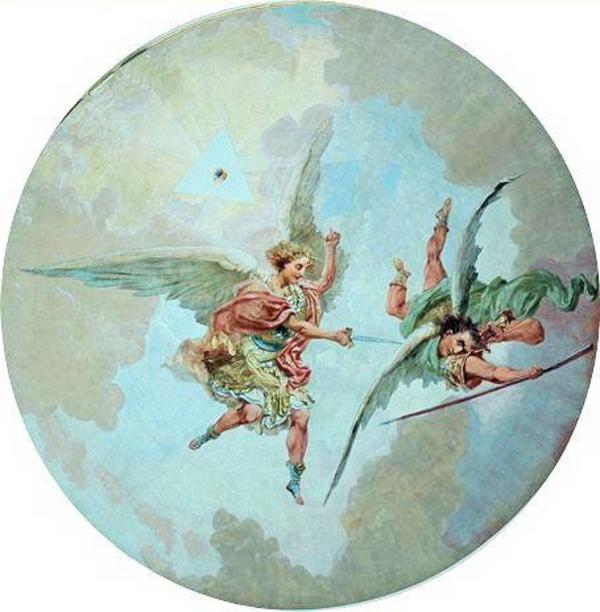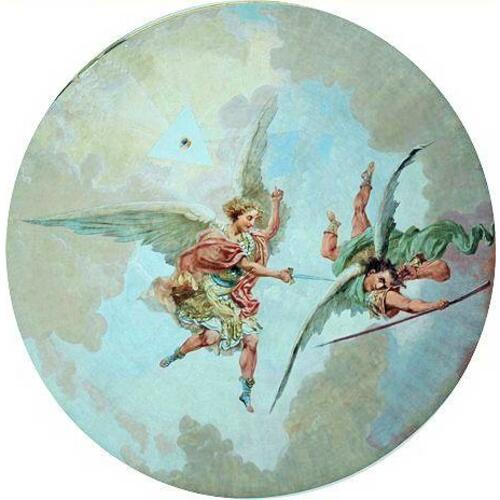
Source: Courtesy of Wikimedia Commons
CAPELLO, LUIGI GIOVANNI VITALE (he also signed some of his works Luigi G. Cappello or Louis J. Capello), decorator and painter; b. 2 Jan. 1843 in Turin (Italy), son of Giovanni Cappello and Caterina Vivalda; m. 22 June 1881 Marie-Louise Lebrun in Montreal; d. 16 Feb. 1902 in Paris.
Luigi Giovanni Vitale Capello’s name has survived in Canadian history because he is recognized as one of the teachers and employers of artist Ozias Leduc*. His impressive output in religious paintings and church mural decoration in Quebec for a period of 22 years earned him a name independent of Leduc.
Capello came from a religious family circle; three of his maternal uncles were priests and his only sister became a nun. He developed his earliest artistic interests from contact with one of his uncles, a priest and amateur painter in Switzerland. Capello’s training was completed at the Royal Academy of Fine Art in Turin, under the direction of professors Enrico Gamba and Andrea Gastaldi, where he won recognition and numerous prizes while still a student. He then visited Florence and studied at the Academy in Rome, before going to Paris in 1875. That year Capello arrived in Montreal, where John Lovell*’s directory listed him as an “Italian artist.” (His name was later given a French version, Louis J. Capello, and in 1887–88 the directory called him a “decorative artist and portrait painter.”) Tradition has it that he had come at the request of the Jesuits to teach drawing and painting in the Collège Sainte-Marie, but their archives only document this activity for the year 1881–82. On the other hand, the four large paintings decorating the chancel in the church of Saint-Paul-l’Ermite which were executed by Capello under a contract concluded with parish priest Louis-Joseph Huot are dated 1874 and 1875; this commission may have been what brought him to Canada.
Over a period of ten years Capello regularly received orders to do decorative murals or paintings for a good many Quebec churches. He painted on canvas or directly on the walls, using a technique adapted from fresco painting. His works were or are in the church in Saint-Hugues (1875), Saint-Alexandre in Kamouraska (1876), Saint-Rémi in Napierville (1877), Sainte-Anne in Yamachiche (1879), Saint-Isidore in La Prairie (1885), Saint-Joachim in Pointe-Claire (1885), and Notre-Dame (1879) and Saint-Joseph (1884–85) in Montreal, as well as in the chapels of the reform school (1877) and Notre-Dame-de-Bonsecours (1879) in Montreal and the chapel of Sacré-Cœur (1883) at the hospice of Notre-Dame-de-l’Assomption in L’Assomption.
Capello’s presence in Quebec was a sign of the rising interest in mural painting being taken in Catholic churches, as shown by Saint-Romuald church, Le Gesù, and the chapel of the Hôtel-Dieu in Montreal. This development had begun in the 1860s with artists of German origin and Capello contributed energetically to it. He had the benefit of the vogue for decorative trompe-l’œil, as practised by Napoléon Bourassa* and François-Édouard Meloche* from the late 1870s.
Although work for churches was his main occupation, Capello tried to find other sources of income. He did stage settings and theatre decoration for the classical college at L’Assomption in 1886, portraits of Pius IX in 1875, Damase Masson in 1879, and Bishop Louis-François Laflèche* in 1882, and even a panorama representing the interior of St Peter’s Basilica at Rome in 1886 for the church of Marie-Reine-du-Monde. From 1880 to 1887, he exhibited with members of the Royal Canadian Academy of Arts and the Art Association of Montreal, showing paintings inspired by Greek or religious history (Une maison grecque au temps de Sappho, Saint Jérome), and some landscapes. One canvas in the exhibition, Scene of the prairies, suggests that he may have travelled in the Canadian west.
Capello’s name is not listed in Lovell’s directory after 1887. His correspondence indicates that he was working in the United States, in particular that year, and in New York around 1896. In 1896–97 he completed his last known commission, for the Ursuline chapel in Trois-Rivières, where in the main he returned to the subjects he had used at Yamachiche. He decorated the dome, the pendentives, and the arch surmounting the high altar with a florid iconographical series of paintings: Saint Michel terrassant Lucifer, Le Sacré-Cœur apparaissant à sainte Marguerite-Marie Alacoque, Le couronnement de Marie, Sainte Angèle Merici et sainte Ursule, Allegorie de la foi, de l’espérance et de la charité, and La Dernière Cène. Capello returned to Turin in 1898; in August 1900 correspondence with the Ursulines of Trois-Rivières places him in the Salesian Brothers’ orphanage in Paris, where he died in 1902.
Hunchbacked, small, and unassuming in appearance, Capello had a wandering and difficult life, and his artistic output, produced in two countries, is barely credited in Canada. His coming to the province of Quebec was confirmation that the clergy who had travelled in Europe wanted their new churches to have well designed iconographical compositions embellished with decorative motifs. Unlike his rivals in the province, both native-born and immigrant, who developed a tradition of painting in grisaille, Capello worked with a rich and varied palette. He created legendary figures with classical profiles, and his feeling for elaborately worked draperies demonstrates the excellence of his training. Enriching the local iconographical repertory, he treated subjects relevant to the new devotions characteristic of the parishes founded in such large numbers during the latter half of the 19th century.
Arch. du Monastère des Ursulines (Trois-Rivères, Qué.), Chroniques du monastère, 6 avril, 14 mai 1897; Lettres de Capello à mère Marie-de-Jésus; Notes laissées par une annaliste, 1886–96, 29 déc. 1896. Qué., Ministère des Affaires Culturelles, Centre de Documentation (Québec), Fonds Morisset, 2, dossier L.-G. Capello. La Minerve, 10 oct. 1874; 13, 26 sept., 26 nov. 1877; 30 janv. 1879; 10 oct. 1884; 3 janv. 1885. L’Opinion publique, 9 nov. 1876. Napoléon Caron, Histoire de la paroisse d’Yamachiche (précis historique) (Trois-Rivières, 1892), 85, 89–94. Collège de L’Assomption . . . (Montréal, [1920?]). Collège Sainte-Marie . . . ([Montréal?, 1882]). Anastase Forget, Histoire du collège de L’Assomption; 1833 – un siècle –1933 (Montréal, [1933]), 71. Francine Lacaille-Laberge et Marcel Chainey, Saint-Rémi: 150 ans d’histoire (Saint-Rémi, Qué., 1980), 27. Laurier Lacroix, “Italian art and artists in nineteenth-century Quebec: a few preliminary observations,” trans. David Homel, Arrangiarsi: the Italian immigration experience in Canada, ed. Roberto Perin and Franc Sturino (Montreal, 1989), 163–78. Alfred Laliberté, Les artistes de mon temps, Odette Legendre, édit. (Montréal, 1986), 77–78. [J.-L.-] O. Maurault, La paroisse: histoire de l’église Notre-Dame de Montréal (Montréal et New York, 1929), 142. La nacelle de Sainte-Ursule . . . (Trois-Rivières, [1897]), 13–15. J.-R. Ostiguy, Ozias Leduc: symbolist and religious painting (Ottawa, 1974), 97, 194. Ozias Leduc the draughtsman, comp. Laurier Lacroix et al. (Montreal, 1978), 29. Jules Romme, Saint-Isidore; deux siècles d’histoire ([Saint-Georges, Qué.], 1983), 118. Christian Roy, Histoire de L’Assomption (L’Assomption, Qué., 1967), 240. J. C. Stirling, Ozias Leduc et la décoration intérieure de l’église de Saint-Hilaire (Québec, 1985), 131.
Cite This Article
Laurier Lacroix and Alexandra Shtychno, “CAPELLO, LUIGI GIOVANNI VITALE (Luigi G. Cappello, Louis J. Capello),” in Dictionary of Canadian Biography, vol. 13, University of Toronto/Université Laval, 2003–, accessed January 19, 2026, https://www.biographi.ca/en/bio/capello_luigi_giovanni_vitale_13E.html.
The citation above shows the format for footnotes and endnotes according to the Chicago manual of style (16th edition). Information to be used in other citation formats:
| Permalink: | https://www.biographi.ca/en/bio/capello_luigi_giovanni_vitale_13E.html |
| Author of Article: | Laurier Lacroix and Alexandra Shtychno |
| Title of Article: | CAPELLO, LUIGI GIOVANNI VITALE (Luigi G. Cappello, Louis J. Capello) |
| Publication Name: | Dictionary of Canadian Biography, vol. 13 |
| Publisher: | University of Toronto/Université Laval |
| Year of publication: | 1994 |
| Year of revision: | 1994 |
| Access Date: | January 19, 2026 |



